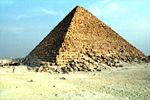 Giza, Egypt, Oct. 20 -- I arrived at the Giza Plateau this morning and was greeted1 by dancers and musicians and young girls waving2 flowers. Business as usual at the pyramids -- they were rolling out3 the red carpet, but not for me. While observing the welcoming parade, I suddenly heard a voice calling my name. I turned to find Julia, a Spanish belly dancer whom I photographed on an assignment4 a few years ago. Small world.
Giza, Egypt, Oct. 20 -- I arrived at the Giza Plateau this morning and was greeted1 by dancers and musicians and young girls waving2 flowers. Business as usual at the pyramids -- they were rolling out3 the red carpet, but not for me. While observing the welcoming parade, I suddenly heard a voice calling my name. I turned to find Julia, a Spanish belly dancer whom I photographed on an assignment4 a few years ago. Small world.
She ran off5 to dance in the desert for the foreign dignitaries6, and I ran off to the inspectorate office to meet with Dr. Zahi Hawass, the director of the pyramids. Today's lineup7 of visitors included several journalists and archaeologists, such as Dr. Dieter Arnold from the Metropolitan Museum, who is currently working on an excavation in Dahshur, and Dr. Rainer Stadelmann, the former8 director of the German Archaeological Institute in Cairo, who has made several significant excavations around the pyramids area.
I was having one of those days in which everything I planned to do did not quite work out9, but by early afternoon, I was off with inspector Essam Hassan Pipers to visit the Third Pyramid, the "little" (relatively speaking -- it stands10 about 62 meters high) pyramid of Menkaure (2490-2472), known to the Greeks as Mycerinus.
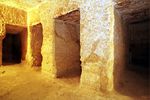
The pyramid is pretty picked over11. The upper casing12 of Turah limestone is gone, and much of the lower 16 courses13 of red granite casing has been removed; many blocks are strewn14 in the desert surrounding the pyramid. Seems that the fascination with the pyramids in the Middle Ages was its potential for building material. The northern face of the pyramid has a huge gash15 created in 1196 by Malek Abd al-Aziz Othman ben Yusef, the son of Saladin, who attempted to dismantle16 the pyramid -- seeing it as a convenient quarry17 for stone. Richard Howard Vyse, in the early 19th century, continued from Othman's dent18 in his search for the entry to the pyramid.
I ventured inside the pyramid, appreciating the ventilation and crowd19 controls inside Khufu pyramid as I practically suffocated amid20 the hordes of tour groups, passing through various chambers until finally reaching the burial chamber -- a big empty room. "Nothing," one man remarked as soon as he got inside. What did he expect? A tomb21 full of wonderful things? Vyse had found the sarcophagus22 and was trying to ship it to England when the boat sank23 in the Mediterranean.
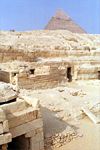
The plan of the pyramid complex here is clearer to see than at Khufu, and all those little drawings and maps I had been studying in books started to come to life. The three queens' pyramids lie to the south, and the remains of the mortuary temple to the east are more extensive than at the Great Pyramid. The king died around 26 years into his reign, before his pyramid was completed, and it's believed that the complex was hastily24 finished in mud25 brick, rather than limestone26, by his son Shepseskaf.
George Reisner did major excavations at the site in the early 20th century, and in 1996, an Egyptian archaeological mission began some new excavations around the site as part of a larger plan to improve the look of Giza Plateau. Hawass is proud of the "Egyptian" part of the mission. For years, major archaeological work has been done by foreign teams. Hawass has been active in getting Egyptian teams in the field.
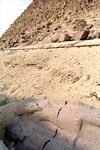
Re-Excavating and Rebuilding
Essam brought me around to the south side of the pyramid, across the "no entry" wire27, to show me some of their recent excavation work. We were joined by chief workman Gamal Sayed il Gamal, who proudly led us to a remarkable discovery -- a 3.4-meter-tall granite pair28-statue, attributed to Ramses II, that was found a few years ago during excavations around the pyramid of Queen Khamerernebty II, when the team was searching for a boat pit29.
Gamal carefully lifted the canvas30 covering the face of the pharaoh as if he were revealing something very precious to him. He was here when they first discovered a bit of the base peeking31 out from the sand. The team worked carefully for a week to dig out the entire statue. Especially on a site where most of the work was re-excavation, a find like this surprised everyone. It is uninscribed -- an unfinished work -- and depicts32 the pharaoh with a solar deity33 standing to his right. The statue has a horizontal crack34 in the middle, and has been left exactly where it was found.
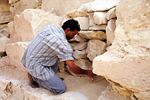
The other recent excavation work is to the south of the causeway35 that revealed tombs that were originally excavated by Reisner, but subsequently36 covered with sand. Four of the tombs were re-excavated, and the hieroglyphic inscriptions over the doorways were restored. It was a peaceful site, the silence punctuated37 only by the clattering38 in the distance of workmen building the stage that will host the millennium celebration -- but more on that later.
My guides left me, and I hung around39 the pyramid until closing time, declining numerous offers for camel and horseback rides, and fighting the urge40 to buy postcards and tiny pyramid replicas for a good price. As much as I can't stand41 these tourist vultures42, a trip to the pyramids would not be the same for me without them, and I have finally figured out43 how to navigate around them.
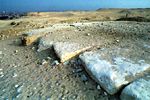
I wandered44 a bit to the west and spoke briefly with an engineer who was surveying the granite casing piles in front of the north face. He spoke in halting45 English, and from what I understood, he was working with a construction company making a plan to replace some of the lower casing stones. Business as usual at the pyramids -- they are constantly working to improve the site.
Many of the visitors seemed to think that the pyramid was a great big jungle gym46, despite warning signs and the vigilant tourist police blowing whistles and waving people down. It is tempting to climb the pyramids, of course, especially with the casing stones gone, making the ascent relatively easy, but more than one person has taken a nasty47 tumble on the way up.
I left the melee48 at the north, and glanced49 to the south across the desert, dotted with50 horses and camels -- everyone out for a sunset ride51. I wondered what might be beneath the ground upon which they rode. Scratch52 the surface of the sands of Egypt, and who knows what you will find. In Baharia Oasis, a donkey literally stumbled53 upon an amazing cache54 of Greco-Roman mummies. Almost 10 years ago, in Giza, an American woman was thrown from her horse near the riding stables south of the pyramids when the animal tripped55 on an ancient mud-brick wall. The archaeologists began digging immediately. Next time, I will go and see what they found.
